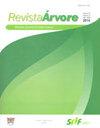FOOD PREFERENCE OF Thyrinteina arnobia (Stoll, 1782) (LEPIDOPTERA: GEOMETRIDAE) ON NATIVE AND EXOTIC HOSTS
IF 0.8
4区 农林科学
Q4 FORESTRY
引用次数: 1
Abstract
ABSTRACT One of the factors that may affect and limit the production in eucalypt plantations is the attack of defoliating insects. Among those, the brown eucalypt caterpillar, Thyrinteina arnobia (Stoll, 1782) (Lepidoptera: Geometridae), stands out for being the major defoliating pest of Eucalyptus spp. in Brazil. Thus, the present study aimed to investigate the food consumption of T. arnobia, in its native host, guava (Psidium guajava L.), and in the different E. urograndis clones (VE 41, I 144, TP 361 and VCC 865). To assess T. arnobia food consumption, choice and non-choice tests were carried out using the native and the exotic host, alone or in combination. In non-choice tests, it was observed a higher consumption for the VE 41 clone and the native host (guava). The food consumption evaluation in choice tests indicated no food preference of T. arnobia between guava and E. urograndis clones, with the exception for the TP 361 clone, which was significantly less consumed than guava. In choice tests between the different E. urograndis clones, the clone I 144 presented a tendency towards lower food preference, being consumed only after 48 hours. In addition, the leaf consumption was similar between the VE 41, I1 14 e VCC 865 clones. In choice tests using the E. urograndis clones in pairs, the VE 41 clone was more consumed while the I 144 clone was less consumed when compared to the TP 361 clone. The obtained results provide basic information for the indication of eucalypt clones, and the understanding of the interaction and ecological relationships, assisting in the development of Forest Integrated Pest Management (Forest IPM) programs for the control of T. arnobia.对本地和外来寄主的食性偏好(鳞翅目:尺蛾科)
影响和限制桉树人工林产量的因素之一是落叶虫的侵袭。其中,棕桉毛虫Thyrinteina arnobia (Stoll, 1782)(鳞翅目:尺蛾科)是巴西桉树属的主要落叶害虫。因此,本研究的目的是研究野野蓟马在其原生寄主番石榴(Psidium guajava L.)和不同的野野蓟马无性系(VE 41、I 144、TP 361和VCC 865)中的食用量。为了评估野蓟马的食物消耗,分别用本地和外来寄主单独或联合进行了选择和非选择试验。在非选择测试中,观察到VE 41克隆和本地宿主(番石榴)的消耗更高。选择试验的食用量评价结果表明,除TP 361无性系的食用量显著低于番石榴外,其他无性系对番石榴的食用量均无偏好。在不同克隆的选择测试中,克隆i144表现出较低的食物偏好,仅在48小时后食用。此外,VCC 865无性系ev41、i1114和VCC 865间的叶片消耗量相似。在选择试验中,与TP 361克隆相比,VE 41克隆消耗更多,而i144克隆消耗较少。研究结果为桉树无性系鉴定提供了基础资料,为桉树无性系间的相互作用和生态关系的认识提供了依据,有助于制定森林有害生物综合防治(Forest IPM)方案。
本文章由计算机程序翻译,如有差异,请以英文原文为准。
求助全文
约1分钟内获得全文
求助全文
来源期刊

Revista Arvore
FORESTRY-
CiteScore
1.00
自引率
0.00%
发文量
32
审稿时长
4-8 weeks
期刊介绍:
A Revista Árvore é um veículo de comunicação científica da Sociedade de Investigações Florestais – SIF. O jornal é de acesso gratuito, revisado por pares, que publica bimestralmente trabalhos científicos originais no campo da Ciência Florestal. As áreas temáticas para publicação são: Ambiência e Conservação da Natureza, Manejo Florestal, Silvicultura e Tecnologia da Madeira e Utilização de Produtos Florestais.
A política editorial visa manter alta conduta ética em relação à publicação e aos seus funcionários, rigor na qualidade dos artigos científicos, seleção de revisores qualificados, respeito profissional aos autores e processo de tomada de decisão imparcial. A Revista Árvore publica artigos apenas em inglês.
Artigos de revisão podem ser publicados se houver uma discussão relevante resumindo o estado da arte sobre o assunto. A revisão estrita da literatura não é aceita.
 求助内容:
求助内容: 应助结果提醒方式:
应助结果提醒方式:


